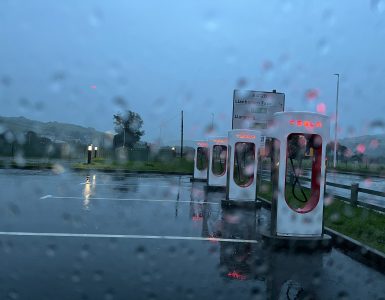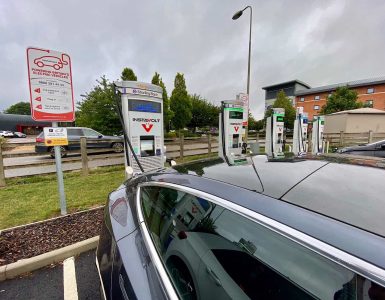Commentary
Our latest review of public charging networks has been very troubling. Essentially while petrol and diesel pump prices have reduced again since our last update, the cost of EV charging has continued to soar. Within Band E, MFG, ESB, Instavolt, and ESG have joined BP, Swarco and Osprey at 79p per kWh with Shell topping the group at 85p! These are all prices that make an EV substantially more expensive than an equivalent petrol or diesel car.
Geniepoint slots in at the very top of band D, at a penny more than Ionity which at 69p per kWh is one of the better value networks now. In most situations even Gridserve at 66p is now above the price of a comparable petrol car and a little less than diesels.
Has there been any good news? Yes, the big news is especially good for Tesla owners. After briefly peaking at a 66p/ kW/h rate for Superchargers, there have been adjustments (and continue to be!). On 4th of December 2022 peak rate for Tesla owners was around 52p (which now only applies between 4pm and 8pm) and an off-peak rate at all other times of just 40p at the time of writing (some locations do still vary a bit) and they seem to change very often!
For non Tesla owners, some UK Tesla superchargers are now open to non Tesla’s, although fewer than in France for example . On a pay as you go basis using the Tesla app the rates are 62p during peak times and 49p at other times. Alternatively, prices fall to around the same at the Tesla owners prices if you pay a £10.99 a month subscription. We estimate you could break even quite easily with regular use of the Tesla Supercharger subscription versus public networks currently priced at 79p, like Instavolt, Osprey, MFG and Swarco and especially if you usually charge at Shell. Remember though you could get most of the savings without the subscription, especially if you stick to off peak Supercharger use.
Tesla pricing can change at the drop of a hat, but if the current prices are held below market rate we can imagine seeing a lot more EV’s switching to Superchargers in the months ahead One word of warning.. if you want to try this out in a non Tesla make sure the Superchargers you need are open to non Tesla’s and try it out on a pay as you go basis before considering subscribing. Some cars simply don’t have a charge port in a place they can reach with the relatively short Supercharger cables. If your EV has a rear left charge flap like all Tesla and the Volvo C40/XC40 EV’s then this shouldn’t be an issue but try before you subscribe.
This is a bold move by Tesla that could proof difficult for other operators.
Contents
Latest DC charging versus fuel price table

Introduction
In our regularly updated review, we look at how the cost of filling up with petrol and diesel compares with charging electric cars in the UK. Then we look at how that has changed compared to a year ago and why largely renewable UK electricity has gone up in price faster than petrol.
These prices are regularly updated with the date displayed at the bottom of the table below.
There is a general assumption that Electric cars are more expensive to buy but charging is always going to be much cheaper than filling up with petrol and diesel. So how is that shaping u
Well in 2022, when both fuel, gas and electricity prices have soared thanks to a spike in oil and gas demand following the pandemic and the Russian invasion of Ukraine.
In fact, in 2022, UK public charging costs are much rising faster than fuel for combustion cars despite the fact that on average only 35-55% of UK electricity is actually generated from oil and gas. Thats partly because the price spikes have hit the gas price harder than the petrol and diesel price. It turns out the UK has a scandalously inept way of deciding how to price electricity that is based almost entirely on the price of gas. And it is hitting EV DC public charging costs hard. We’ll explain why.
1 How we compare the costs – Petrol v Diesel v Electric
It’s quite hard to compare the cost of a liquid fuel burnt inside a piston engine with electricity running electric motors so we’ve made it super easy. We’ve taken RAC fuel price data on the date shown and done the maths. You just compare the cost in pounds to drive 1,000 miles.
We’ve also split the results into green for the most economical cars, yellow for average and red for the least uneconomical. Just like for piston cars, some electric cars are very heavy and inefficient so they don’t travel as far as many miles per kW/h as more efficient cars. Just look at the actual economy of your piston or electric car to compare costs.
Charging prices vary a lot, so we’ve also picked a few price points that most UK charging networks are close to, for quick DC 50-350kW charging that usually takes between 18 and 40 minutes. We’ve also added some very poor and very good value slow AC chargers.
If you don’t like comparing cost per thousand miles just move one decimal point to the left to get the price per 100 miles or pence per mile. e.g.
- £157 per 1,000 miles is the same as £15.70 per 100 miles
- The same number is also the cost in pence per mile ie 15.70p so it’s easy to compare our numbers with all 3 metrics
- If you want to try your own mpg or different prices per litre, there is a handy calculator at Fuel Economy UK
2 Cost comparison results – what do they tell us?
- Firstly, whatever car you drive it’s how efficient it is that makes the biggest difference to what you pay. If you drive a petrol or diesel in the green column that is really averaging 50mpg or more then congratulations. For every 1,000 miles you may save over £100 compared to a petrol or diesel driver in the red column with 30 mpg.
- By comparison the savings you get switching to an electric car right now aren’t great when public charging, in fact any charging network over 69p per kWh is costing you more than petrol and often more than diesel as well.
- Want to save fuel cost without changing cars?
Well all cars are least efficient on short urban journeys when walking, cycling or public transport might be easier.
Not running your engine when parked up would also cut your fuel bills easily and cut pollution too
Driving at 50-60mph will save you money compared with driving at 70mph or more
Finally driving more efficiently, accelerating less hard and coming off the accelerator early when you are heading to a stationary queue or red traffic light will mean you get much further with each litre or kWh you purchase. It will also save money on brake pads. - Tesla– As a reference point the very efficient Tesla Model 3 and Y electric cars will probably deliver an average of 3.5 miles per kW/h over the whole year so between the green and yellow columns. Tesla Superchargers pricing briefly went up in price with the market, however prices have now come down again and the peak price is now onl between 4pm and 8pm at the time of writing.
- It’s worth bearing in mind when you’re not DC charging some slow AC chargers are sometimes much cheaper or even free..in a yellow efficiency electric car, charging on a home overnight 7.5p off peak tariff you might be able to cover 1,000 mile for just £22.50!
- Electric car owners will sometimes pay as much or more than petrol or diesel drivers, but many also have the chance to charge at 10x less. If they have their own solar panels charging might even be free. So while petrol and diesel prices pay much more similar prices everywhere (just about 20% on the at Motorway services), the average electric car drivers pay from different sources should usually still be lower over a year even now.
- Charging network prices should fall during the lifetime of your electric car. At the moment pressure on prices is still upward. Some networks may offer off peak discounted rates overnight.
3 What’s happened to fuel v charging cost in the last 12 months?
Well, it turns out charging costs for electric cars have been rising much faster than the prices for petrol or diesel. As we a rule of thumb we estimate any price over 69p per kWh (BAND E in the table above) is substantially more expensive than petrol or diesel in any relevant comparison, while Band D will be slightly more.
At the moment, although Osprey did come down from their £1 per kWh rate the trend is still upwards with Shell, Osprey, SWARCO, BP, MFG, Instalvolt and ESB now firmly in the most expensive Band E.
| 2021 Price | 2022 Price | Increase |
|---|---|---|
| 41p | 85p | Shell* +107% |
| 36p | 79p | Osprey +119% |
| 33p** | 79p | Swarco +139% |
| 42p** | 79p | BP Pulse* +88% |
| 35p** | 79p | MFG +126% |
| 30p | 75p | Instavolt 150% |
| 35p** | 75p | ESB 114% |
| 39p | 73p | FastNed +87% |
| 39p** | 70p | Geniepoint +79% |
| 69p | 69p | Ionity +0% |
| 69p | 65p | Source London PAYG -6% |
| 30p | 66p | Gridserve* +120% |
| 24p | 49p | Ubitricity Shell lamp posts +104% |
| 30p | 44p | Tesla peak +46% 4pm-8pm |
| 23p** | 40p | Podpoint Lidl +73% |
| 30p | 34p | Tesla off peak +13% |
| 30p | 30p | Chargeplace Scotland 0% |
| 38.1p | 64.1p +3 | Basket average Up 68.2% |
Petrol and diesel fuel prices in the fluctuate. During the pandemic they fell to around 117p per litre but assuming more normal prices they went from
- From 127p to 161.60p – 30.6% rise for petrol
- From 130p to 185.781p – 46.4% rise for Diesel .
For charging let’s look at an Autocar review of various charging companies in their article 20th January 2021
As you can see it’s not petrol and diesel drivers that should be clamouring for relief from soaring prices, in fact charging costs are rising much faster than fuel.
4 Why are UK charging costs rising so much faster than petrol and diesel? Is it the Government or the Russians or the French?
Petrol and diesel
Well we’re comparing 2 things so starting with the price of petrol and diesel. Why hasn’t it gone up more? Well for a start gas prices for electricity generators have risen in price faster than petrol and diesel. The main reason though is is fuel duty which for years had been fixed at 57.95p for both fuels, but reduced to 52.95p in March 2022. By contrast the cost of the actual fuel and biofuel contributes only about 67p to the cost of a litre of petrol at the pumps at the end of May 2022. Then there is delivery, retailer margin and VAT. Essentially only about 40% of the price of petrol goes up directly with rise in refined price of petrol or diesel. Remember that 40%
How UK electricity prices are set
So what about electricity? Well electricity is also 60% produced from sources like wind, solar, nuclear and biofuel that haven’t changed in price. Just under 40% comes from gas which has gone up massively in price recently. So why has the cost of UK electricity gone up so much (which is feeding into much higher EV charging prices)
For company energy bills the Government assistance doesn’t apply, so their cost of electricity is set by the UK wholesale price.
Let’s look at the words of the Chancellor during his 26th May 2022 “windfall tax” statement.
Certain parts of the electricity generation sector are also making extraordinary profits. The reason for this is the way our market works. The price electricity generators are paid is linked not to the cost they incur in providing that electricity but rather to the price of natural gas, which is extraordinarily high right now. Other countries like France, Italy, Spain and Greece have already taken measures to correct this”
Then Chancellor Rishi Sunak during his 26th May 2022 “windfall tax” statement.
So, to sum up, the former Chancellor is admitting that the reason UK electricity prices have gone up so much is because it is being pegged to gas prices. In fact the way the market operates is even stranger. Generators bid to provide power for half hour periods. Wind and solar might be 4p per kWh, Nuclear 13p but during peak times gas is needed as well. If the gas bid is for example 40p then every generator (including wind, solar and nuclear) all get paid the price offered by the worst or highest bidder. In this example they all get 40p even if they bid just 4p!. This is how the UK prices for electricity customers is set.
The government is currently “consulting” to change the system but unlike France, Spain Italy and Greece appears not to be in any rush. Instead the government appears to have decided to let generators make windfall profits and then use taxpayers money to compensate some electricity users for the the obscene electricity bills this flawed market delivers.
The French Nuclear problems
So the cost of gas crisis has paradoxically hit electricity prices hardest. There is one other curious factor at play and it’s the French!
Nothing sinister but France produces most of it’s electricity from nuclear power stations and often send surplus power to the UK via undersea cables known as interconnectors.
Unfortunately with abysmal timing in the spring and summer of 2022 half of all the Nuclear power plants in France have had to be taken offline for a combination of regular maintenance and emergency repairs.
As a result, instead of the UK grid being topped by French electricity UK generators had to burn lots of expensive extra gas to keep the French grid up and running. Quite proper as they often help us, but it means we are burning extra gas in UK and are likely to have much longer periods needing gas plants operating at peak demand mode.
In fact the French have since been hit with a further problem, many nuclear plants are increasingly having to reduce their power production or shut down in summer. Why?Nuclear plants use a vast amount of cold water from rivers or the sea in order to condense the steam and hot water they created. Unfortunately, for the inland power plants the summer symptoms of climate collapse include
- Reduction and soon the elimination of very cold water released from mountain snow melt and glaciers in spring and summer meaning rivers will dry up quickly and more frequently when there hasn’t been regular rain
- Less frequent and regular rainfall.. and when it comes much heavier rain and flash flooding that could damage critical infrastructure near rivers.. like roads, bridges, railway lines and.. power plants
- heatwaves causing higher lake and river temperature
When you add hot water to a river that is already warm you risk killing all river life downstream. Even relaxing the rules on this ( as France has in summer 2022) isn’t a long term solution as many of these rivers won’t have enough water to use. In addition the power plants may find they need even more water to operate because warm river water won’t be as effective at cooling as the cold river water these plants were designed for. Paradoxically then, Nuclear plants may cease to be a dependable source of power in heatwaves and droughts (ie our future summers), with renewables including solar in particular, needed to make up the difference. More details on this article from the medium here
5 VAT on charging
Wholesale price is is the main thing driving electric charging prices skyward. The other is that the Inland Revenue prevailed in a dispute over whether the VAT on public charging bills should be levied at 5% or 20%. As a result charging companies have to add 4x as much value added tax than is paid by someone charging at home. Because VAT is a percentage levy, the tax portion of a bill goes up in lockstep with a price increase. By comparison fuel duty is usually a fixed amount, and was reduced in early 2022.
6 Conclusion
Neither of these Government created issues are within the control of charging networks. The good news is when one or both are fixed, charging costs should begin to fall from current peaks, even if oil and gas prices remain high.
Essentially the UK government’s fuel duty stabilises the cost of petrol and diesel, while the same Government’s tax system and completely dysfunctional market for setting wholesale electricity prices, seems designed to destabilise electricity prices.
The government really needs to focus on this issue. On the path to net zero, it makes no sense to artificially inflate the cost of low carbon electricity but 10x or more. Making electric cars and heat pumps more expensive than they should be relative to fossil fuel cars and gas heating and cooking slows the transition. In some cases drivers of plugin hybrids may even decide it’s cheaper to just burn petrol than to charge their batteries.
One of the benefits of clean renewable energy today is cheap and stable pricing. It’s important consumers of energy are able to appreciate that a small and shrinking proportion of our energy comes at highly volatile prices purchased from dodgy dictators. Instead the Government has provided a perverse opportunity for some climate change deniers to falsely claim renewables are driving up household energy bills when the opposite is true.
From a policy perspective many people are suffering from soaring energy costs. Providing relief on the electricity price through market reform not only fits with the long term green agenda, it is also more equitable because almost every household in the land uses electricity, whereas a larger and growing proportion don’t use gas. For UK households it is total energy bills that matter. Whether relief comes from market reform of the electricity market without subsidy, or direct taxpayer subsidy of fossil fuels is immaterial to most consumers but it does matter to our future success in achieving net zero goals.







[…] sense than ever right?Unfortunately 2022 hasn’t been shaping up that way. Costs of buying and charging an EV (Electric Vehicle) have been rising sharply. A combination of chip shortages, COVID shutdowns in […]